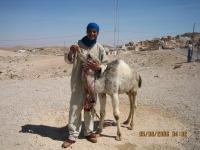The iron graveplates told the names of those buried behind them, and above some of them were the heavy iron chains the penitents had voluntarily worn during life, to be removed only in death. Scraping away the soft sandstone with bits of wood or with only their finger-nails, the monks dug their own graves. To make one was the task of years - a lifetime spent getting ready for death - the next step upward after withdrawal from the world. Here a double grave witnessed to a close friendship between two monks, who worked together, prayed together, and were finally buried together. Their affection, like a white plant grown in a cellar, still shone in the dark.
As we emerged from the candle-lit gloom of the interior into the leaf-filtered emerald sunlight of the garden, we saw two monks pacing on their way to ring the great bells that hung in the zvonnitza - the white many-arched belfry, roofed with green. One of them went across to where the bells hung - I don’t know what his office was; the other, a rather handsome, shabby, completely expressionless young man, mounted to the second-story balcony of the opposite building and began pulling on the long bell ropes. As he pulled a rope toward him, and one bell clanged, he bent far backward, then forward again to grasp another rope, bringing forth a peal from another bell. Ringing his tune, he swung now to the right, now to the left, and now reached upward, dancing with fixed feet and swaying body. The clangor of the bells resounded in pious song, rushing out under the trees under the archways, rolling along the walls, calling the town and the countryside to prayer.
As the clangor died and the overtones sighed away to the skies, the people, answering the call to worship - monks, townfolk, and peasants - all telling beads, moved quietly toward the church; and we went on to the red-and-white-painted riznitza - or treasure chamber. This is a small octagonal building, with eight archways, and a domed roof, gilded points all around it like the points of a crown - gay without, and barbarically rich within. Here are the coronation robes of all the Czars, beginning with Ivan and ending with Nicholas II. They are displayed at full length in glass cases - incredibly gorgeous robes, embroidered with seed pearls and clasped with jewels. There are maces and crowns, and swords set with rubies and emeralds, and parchment manuscripts, jeweled books of prayer, and priceless reliquaries.
Advertisement / Reklaam
Advertisement / Reklaam
All this well-known wealth nearly brought destruction on the monastery. For during the war of Independence the Bolsheviks tried to gain control of it and of the surrounding territory. But the people, although Russians and Slavs, were also free-hold farmers, and the Estonian Government won their allegiance by promising them the continued ownership of their farms - that ownership they had long so dearly cherished. They fought desperately for their homes; and the pleasant countryside saw more than one battle. Many men were killed on both sides; but the peasants finally drove the Bolsheviks back to the other side of the boundary lake.While this was going on, the monks had time to hide their treasures far within the recesses of their catacombs where no enemy could find them. Since peace has been restored, the treasures have been brought out into full view again. The Estonian Government, far from seeking to confiscate their treasures and oppose their religion, has shown its good will by erecting a modern sanitary apartment building for the monks, among the ancient Russian buildings. The long day was drawing to a close, and we were far from home - that is Tartu; but my friends thought I must first see an ancient fortified town, of whose name I am uncertain. As we drove along we could now and then catch a glimpse of Lake Pihkva which, with Lake Peipus, forms much of the boundary between Russia and Estonia. The countryside was altogether unlike that through which we had been driving - more abrupt, more pre-historic, like a primitive place that still remembered the ice-age.
As we approached a high hill crowned with an ancient fortress and encircled by a great wall of tremendous thickness, we left the car and climbed the height, whence we looked out over a rough and rather terribly beautiful valley, carved out by the grinding ice of a retreating glacier, which had left in its track a stream that still flowed through the depths and drained many little round, blue lakes.
Within the walls, the enclosed grass-grown circle was like the roofless family-room of an old home. Just outside clustered the barns, houses, and small shops of the village. Set a little apart in its church-yard, a beautiful small church, so modern it was not fortified, kept watch over the sleeping dead, its bell hanging ready for funeral toll, or wedding peal, or weekly call to worship.
Advertisement / Reklaam
Advertisement / Reklaam
Over the fields where men had toiled so many centuries, and for which so many had recently died, the setting sun, now that midnight drew near, threw its last level rays. A mother sitting on the worn door-step of her home, her grey bearded father smoking his pipe beside her, sang her baby to sleep with an old Russian melody. The song rose into the quiet air. The old stones tonelessly echoed them, the clouds received them, and the winds blew them softly over the land.* * * * * * *
Here, in this Southeast corner of Estonia, we caught a glimpse of non-communist Old Russia, relieved of Czars and Grand Dukes, not subjected to a Dictator and an idealist Party, but functioning after its own pattern under a reasonable government.
(To be continued)




















